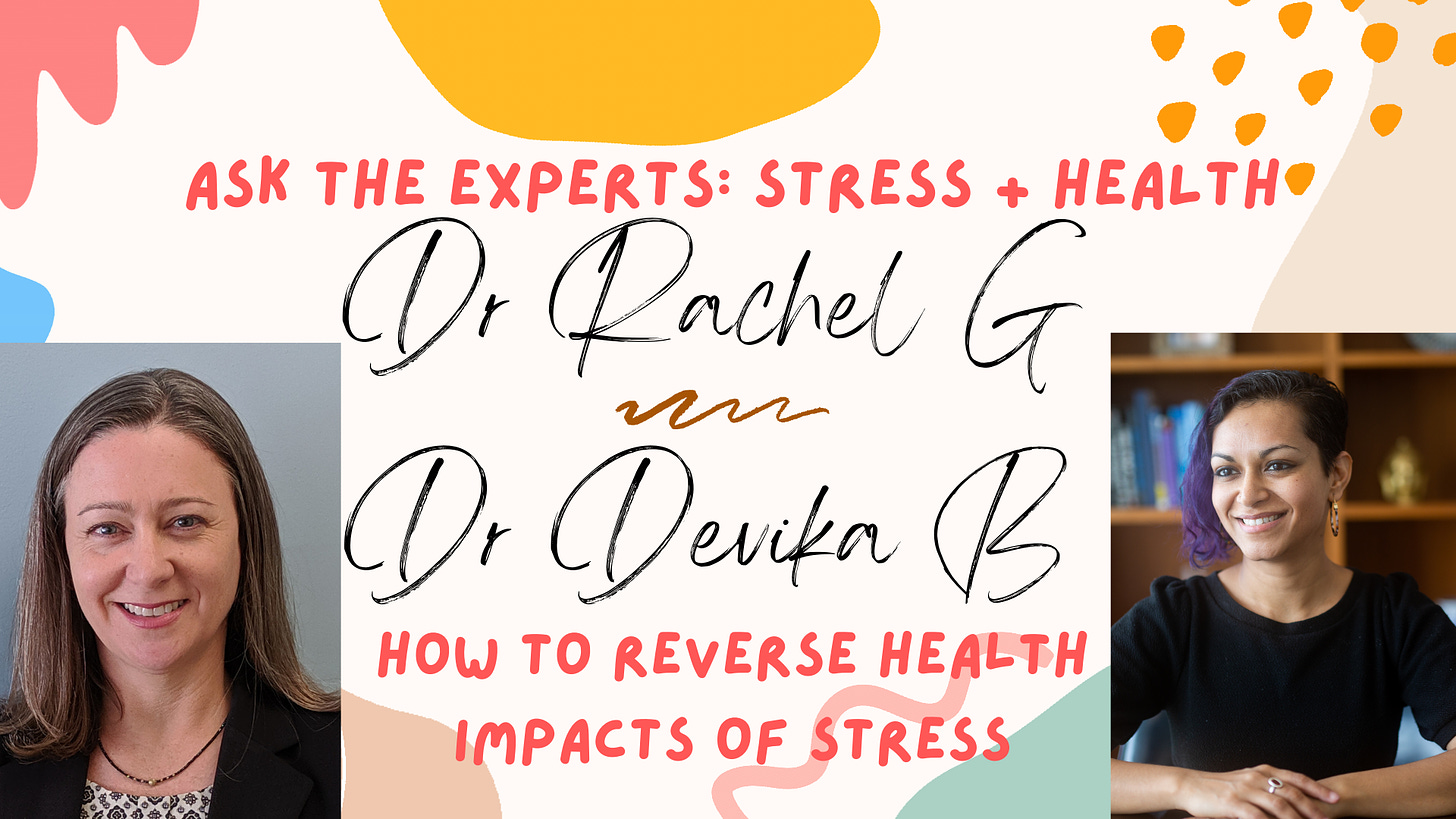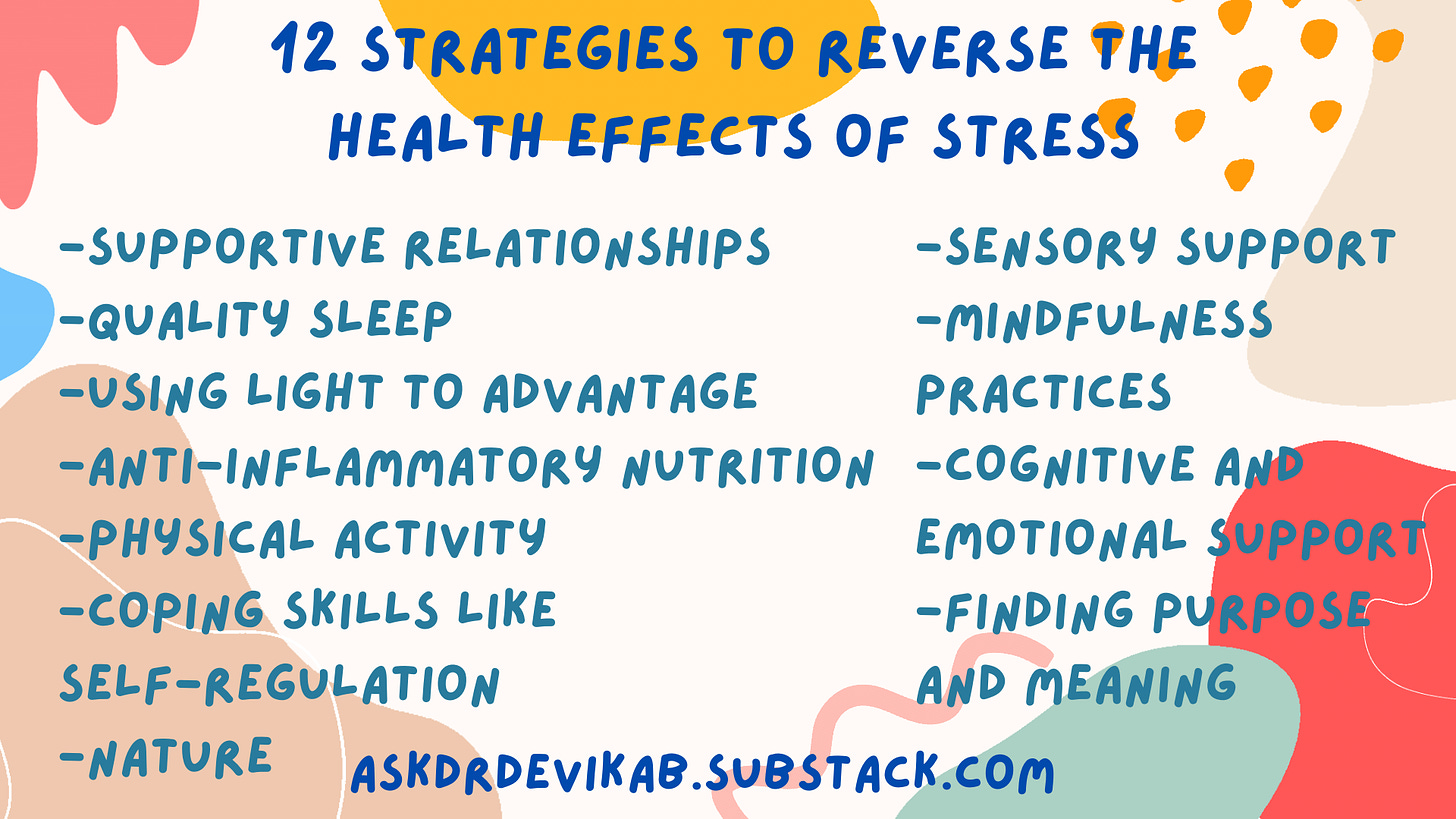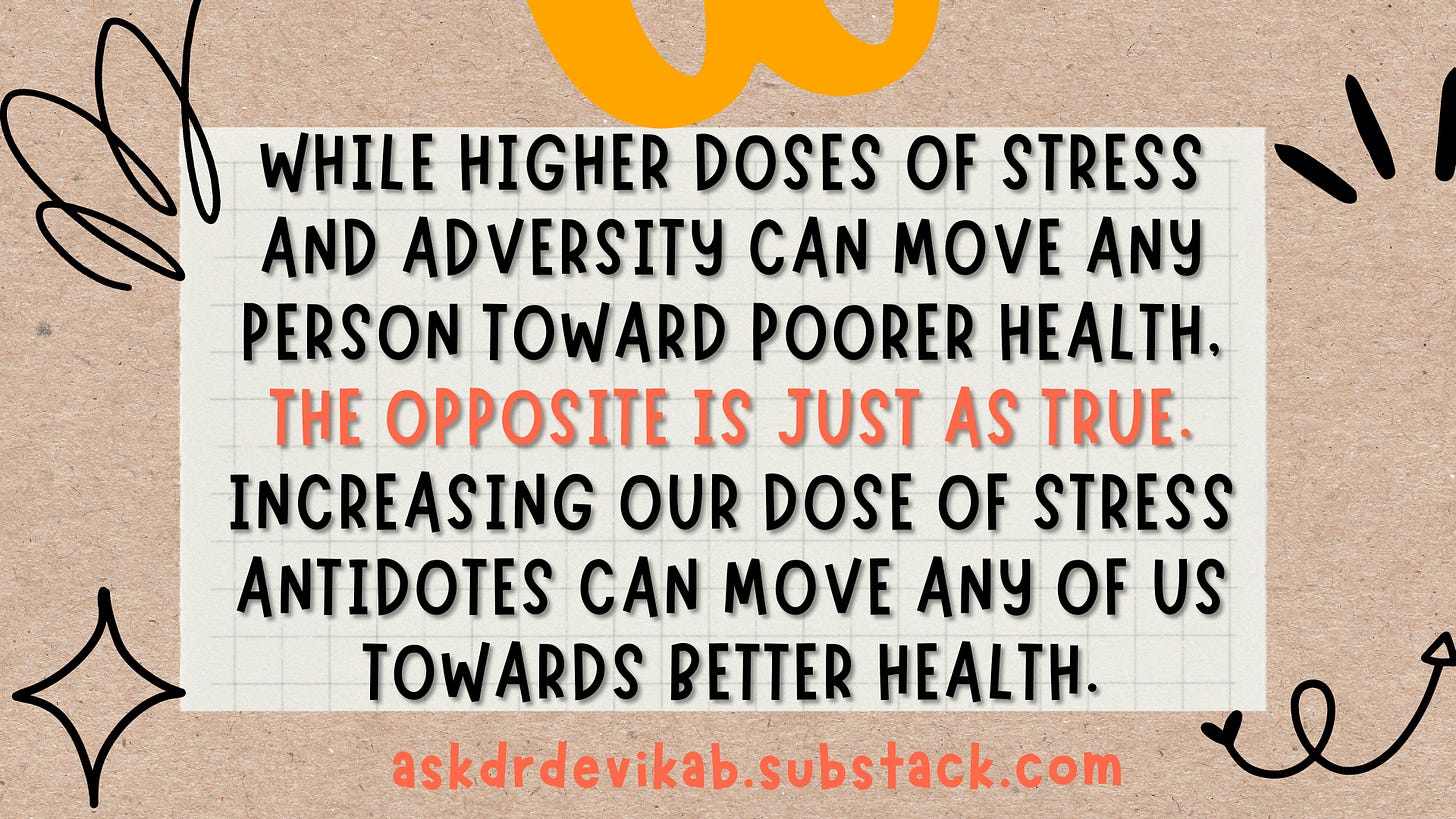Deep dive, stress and health part III: Reversing the health impacts of stress
Stress and health mini-series: Part III of IV
Dear community,
How are you doing? Appropriately in the middle of #MentalHealthAwarenessMonth, here is our third installment of the stress and health mini-series — on evidence-based antidotes to health effects of stress. Several are enshrined as part of the ACEs Aware initiative in California, where we equip clinicians and patients to think differently about healing from childhood trauma.
My hope for our community is that the bite-sized, actionable principles we present in this four-part series on stress and health will empower each of us to better steer our bodies towards a healthier response to stress — now and in the future, ultimately allowing us to lead healthier and more satisfied lives.
In this four-part miniseries, Dr Rachel Gilgoff and I break down:
I: Stress and health — the basics: article | video
II: Turning off the stress response in the moment: article | video
III: How to reverse the health impacts of stress (today): article below | video
II and III+: My personal favorite ways to destress: article
IV: How to help someone after a traumatic event: article | video
Dr Rachel Gilgoff is an integrative medicine specialist, child abuse pediatrician, Stanford stress researcher, science writer, and mother of two amazing kiddos. She is dedicated to improving care for stress-related health issues and promoting lifelong health and wellness.
Dr Devika Bhushan is an equity- and resilience-focused pediatrician, public health leader, parent, and Indian-American immigrant who served as California’s Acting Surgeon General in 2022.
A modified version of this article also appears on the American Academy of Pediatrics’ parent-facing website, healthychildren.org.
Wishing you light,
Dr Devika Bhushan
Reversing the health impacts of stress
Going through something stressful — like losing a loved one or even the wear and tear of constant stressors like caregiving responsibilities or discrimination and other impacts of racism or sexism, for example — can affect any of us over the long run in sometimes unexpected ways.
You’ll recall that the stress response can be lifesaving, like when we face a predator. However, repeated, prolonged, or excessive activation of the stress response can lead to wear and tear on our bodies. It can affect our brains, hormones, immune systems, and even our genes—and potentially lead to poorer mental and physical health.
The flip side is that we have powerful access to evidence-based tools that can a) help us turn off the stress response in the moment — and b) even reverse the longer-term health impacts associated with a stress response that has been activated over and over again (described below) — so we can each feel our very best.
These strategies can help us do exactly that. They apply to adults and kids; where relevant, we’ve included adaptations for children, marked with a ^.
Admittedly, we do not all have equal access to the energy, time, and space it takes to enact these strategies — structural constraints matter a lot. But the beautiful thing is, many of these can provide benefits with whatever time or space we do have — even in a few minutes, we can see the nourishing impacts of time outdoors or a mindfulness practice.
I know the difference when I get a full night’s rest and have the opportunity to walk outside in the fresh air and sunshine, tuning into the birdsong and scent of fresh flowers — in how I then interact with myself, my son, others in my life, and my work. We know as caregivers or individuals in this world that we have to fill our own tanks up first before we can be there for anyone or anything else.
In an upcoming post, you’ll hear more about how I put these strategies into place in my own life.
Healing tools and strategies
Supportive relationships
Connection and safety through supportive, nurturing relationships can make all the difference when we’re struggling through something stressful.
For adults:
Connect with loved ones who bring us joy and meaning regularly (especially hard when we’re not feeling our best)
Create opportunities for high-quality time together, like watching a comedy show (including online), cooking or eating together, or just talking through what’s on your mind
A quick call or text saying you miss someone or sharing a favorite memory or something you love about them can be really meaningful for both parties
Don’t be afraid to ask for help if you’re doing through something tough, including for basics like childcare. When you’re feeling better, you’ll be able to give back to your community in all the ways that you’re receiving help just now.
Consider reaching out to community-based services for help with basic needs
^Try these activities with your child:
When possible, reassure your child that they are safe. You can do this with words, but also with hugs, high-fives, and practical supports like a tent or a “cozy corner.”
Take ~15 minutes without cell phones to follow their lead in an activity of their choice
Share activities like walks, cooking, dancing and playing silly games
Tell your child what you love about them
Build routines like reading a bedtime story or having dinner together every night
Quality sleep
Sleep is fundamental to recovery and health, and it can be one of the first things to suffer when we’re stressed. Worries may keep us awake or cause restless sleep. Some things to try:
Be strategic about exposure to light and dark (see below)
Try going to sleep and waking up around the same time each day
Use comforting bedtime routines like: reading, journaling, listening to calming music, relaxing smells, deep breathing or meditation, stretching or yoga.
^When children are stressed, they may need more flexible bedtime routines and extra help falling asleep, such as:
Comforting items and relaxing routines:
A night light
Relaxing smells
Favorite toys
A weighted blanket (only if child is > 12 months)
Music
Mindfulness practices
Journaling
For children experiencing separation anxiety at night (common after stressful or traumatic events), consider leaving items that give extra reassurance:
Love notes stuck around the bedside
Pieces of clothing that smell like you
For some children, consider staying in the room while they fall asleep or even letting them sleep with you for a short while as they process the stressful experience
Using light to your advantage
During the day, especially early on, get direct exposure to natural sunlight. This helps regulate sleep, mood and immune function, among other systems.
At night, reduce exposure to screens and artificial lights by dimming them. You can even use blue light-blocking glasses to limit exposure to the blue wavelengths of light that wake the brain up by turning off the sleep-inducing hormone melatonin and disrupting sleep.
Balanced, anti-inflammatory nutrition
Stress can increase inflammation and lead us to over- or under-eat or crave foods high in fat, salt, and/or sugar. Knowing this can help us be kind to ourselves and our kids when they reach for the brownie and the potato chips—and to help ourselves in those moments.
Skip the juice and soda and drink water instead
Reduce foods that increase inflammation such as processed food and white (simple) carbohydrates
Make it easier to reach for healthy, high-fat or high-sugar foods like nuts, avocados, cheese (in moderation), and fruits
Increase the availability of vegetables (fresh or frozen!) at snacks and meals
Physical activity
Regular exercise can be a powerful way of releasing extra stress energy and counter-acting the stress response. Any amount of exercise — even a few minutes — is helpful. Several times a week, try to get up to 30-60 minutes a day, and it doesn’t have to be all at one time. A few pushups between Zooms, getting off the bus a few stops early to get in those extra steps, some bedtime yoga: it all adds up.
Bottom line – get your body moving whenever you can and ideally, try to sweat and get your heart rate up.
Consider:
Jumping jacks, squats or bridges
A game of basketball or other fun team sport
Dancing to a favorite song
Martial arts
Yoga
Getting out in nature
Time outdoors can be calming for the nervous system and pairs well with exercise — and with spending time with others. I love doing a ‘walk and talk’ outdoors with a close friend.
Check out a local park or a playground
Walk around the block
Hike
Mindfulness
Mindfulness practices can help calm stress physiology, improve self-regulation, and increase self-compassion and empathy. Try one of these:
Meditation or mindful breathing
Focusing on each of the five senses while sitting still
Watching the sunset or sunset — or clouds drift on a clear day
Using free online videos and apps for kids and adults
For kids: belly breathing with Elmo, with Rosita, or 4-7-8 breathing
Sensory support
Soothing, rhythmic sensory activities can help reset the way stress is stored in our nervous system and body. Consider:
Massage
Music
Movement — especially rhythmic activities: dancing, walking, jumping, swinging, rocking, swimming
Occupational or physical therapy
Finding purpose and meaning
Especially when we wonder, ‘Why did this happen?’ and ‘Why me?,’ activities that help us make meaning of our experiences can be really helpful in grounding us and guiding us forward.
Consider:
A spiritual practice or connecting to a religious community
Helping others through service or volunteer work
Finding a calling or purpose, including helping fix systemic injustices
Becoming a peer supporter
Cognitive and emotional support, including coping skills
We can better cope with stress once we learn specific skills to manage our more difficult feelings and behaviors, including how to set boundaries and self-regulate.
Consider when you might need to seek extra help or take a period of time away from work or school to attend to your health.
There’s no shame in needing extra support through mental health therapy for yourself or a child or loved one. Therapy can be super valuable in helping to practice the tools presented here and to develop additional coping skills. Depending on your needs, consider exploring work with a therapist or other supports.
^Children going through a stressful experience may benefit from extra supports through:
School-based 504 plans or Individualized Education Programs (IEPs)
Speech and language therapy
Tutoring
Specific therapies like art therapy, play therapy, or family therapies like parent-child interaction therapy, and child-parent psychotherapy
We’d love to hear from you — what’s been helpful for you in overcoming impacts of especially stressful life experiences and periods?
What are you finding especially helpful to help navigate stress in this current season of your life?
Leave a comment, share this newsletter/post, or subscribe using the buttons below if you’ve received this from a friend.
Events coming up:
Mark your calendars! On Mental Health Action Day, join NAMI Ambassador Alessandra Torresani and I for a candid conversation about our mental health in an IG Live here. We’d love to see you on May 18, 1 pm PT/4 pm ET. We’ll be sharing our personal stories and touching on these mental health strategies.
If you’ll be at the American Psychiatric Association’s annual meeting in San Francisco this week, I’ll be speaking with colleagues on two panels — come say hi!
Bhushan D, Jadhav M, Rafla-Yuan E. Translating between the social and political determinants of health, where I’ll be speaking about California’s policy approaches to preventing and addressing trauma and toxic stress
Bhushan D, Myers MF, Worley LLM, Hart D. The end to stigma begins with us: How physicians can address stigma in the medical profession and beyond








